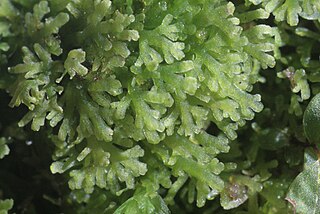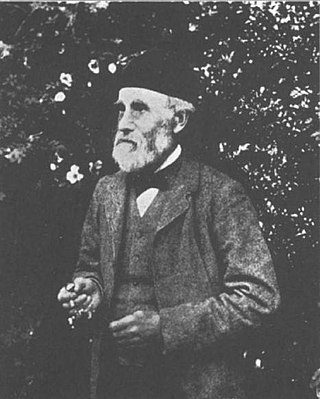
Lichenology is the branch of mycology that studies the lichens, symbiotic organisms made up of an intimate symbiotic association of a microscopic alga with a filamentous fungus.

The Marchantiophyta are a division of non-vascular land plants commonly referred to as hepatics or liverworts. Like mosses and hornworts, they have a gametophyte-dominant life cycle, in which cells of the plant carry only a single set of genetic information.

Hornworts are a group of non-vascular Embryophytes constituting the division Anthocerotophyta. The common name refers to the elongated horn-like structure, which is the sporophyte. As in mosses and liverworts, hornworts have a gametophyte-dominant life cycle, in which cells of the plant carry only a single set of genetic information; the flattened, green plant body of a hornwort is the gametophyte stage of the plant.

Metzgeriales is an order of liverworts. The group is sometimes called the simple thalloid liverworts: "thalloid" because the members lack structures resembling stems or leaves, and "simple" because their tissues are thin and relatively undifferentiated. All species in the order have a small gametophyte stage and a smaller, relatively short-lived, spore-bearing stage. Although these plants are almost entirely restricted to regions with high humidity or readily available moisture, the group as a whole is widely distributed, and occurs on every continent except Antarctica.
Ilma Grace Stone, née Balfe, was an Australian botanist who specialised in bryology. She was an author, collector, and researcher of Australian mosses, a subject on which she lectured and wrote.

The American Bryological and Lichenological Society is an organization devoted to the scientific study of all aspects of the biology of bryophytes and lichen-forming fungi and is one of the nation's oldest botanical organizations. It was originally known as the Sullivant Moss Society, named after William Starling Sullivant. The Society publishes a quarterly journal distributed worldwide, The Bryologist, which includes articles on all aspects of the biology of mosses, hornworts, liverworts and lichens. The Society also publishes the quarterly journal Evansia, which is intended for both amateurs and professionals in bryology and lichenology and is focused on North America.

William Mitten, was an English pharmaceutical chemist and authority on bryophytes who has been called "the premier bryologist of the second half of the nineteenth century".

Aneura mirabilis is a parasitic species of liverworts in the family Aneuraceae. It was first described in 1933, as Cryptothallus mirabilis. Plants of this species are white as a result of lacking chlorophyll, and their plastids do not differentiate into chloroplasts.
The International Association of Bryologists (IAB), established in 1969, is a professional association promoting bryology globally for both amateurs and professionals. IAB was established in 1969 at the XI International Botanical Congress in Seattle, Washington, with the goal of increasing cooperation between professional and amateur biologists throughout the world. The organization sponsors conferences and meetings relating to bryology, and sponsors the publication of The Bryological Times and Advances of Bryology. Together with the International Union for Conservation of Nature (IUCN), they compiled the first red list of endangered bryophytes in 1997.
The British Bryological Society is an academic society dedicated to bryology, which encourages the study of bryophytes. It publishes the peer-reviewed Journal of Bryology.

William Campbell Steere (1907–1989) was an American botanist known as an expert on bryophytes, especially arctic and tropical American species. The standard author abbreviation Steere is used to indicate this person as the author when citing a botanical name.
Jan-Peter Frahm was a German botanist dedicated to the study of mosses. The standard author abbreviation J.-P.Frahm is used to indicate this person as the author when citing a botanical name.

Margaret Sibella Brown was a Canadian bryologist specializing in mosses and liverworts native to Nova Scotia. Although lacking formal scientific training, she has been recognized for her contributions to bryology and as an authority on the mosses and liverworts of Nova Scotia. Samples she collected are now housed at major herbaria in North America and Europe.

Alexander William Evans was a botanist, bryologist, and mycologist that specialized in the flora of Connecticut.
Geneva Sayre was an American bryologist and bibliographer. She "pioneered bibliographical and historical bryology, a new field in the study, evaluation, and organization of the literature of bryology."
Wilfred "Wilf" Borden Schofield was a Canadian botanist, specializing in mosses and liverworts. He was considered by many "the foremost bryologist in Canada".
Martha Elizabeth Newton was a British bryologist and botanist, specialising in cytology and field surveying.
Eric Vernon Watson (1914-1999) was a British bryologist.

Tamás Pócs is a Széchenyi Prize-winning Hungarian botanist, ecologist, and college professor, and member of the Hungarian Academy of Sciences. His research interests include the taxonomy and distribution conditions of mosses, tropical ecology, and the flora of Southwestern Transdanubia and the Southern Carpathians. His name is associated with the collection of many plant specimens and the description of one hundred and forty new plant species. Between 1991 and 1995 he was the president of the Hungarian Biological Society. His great-grandfather Ferenc Kozma (1844–1920) was a teacher, publicist and academic; his sister Éva Pócs is a folklore researcher.
Jean Annette Paton is a British botanist, bryologist and botanical illustrator. She has written many books on the bryology of the United Kingdom and the flora of Cornwall, and described several new species.











